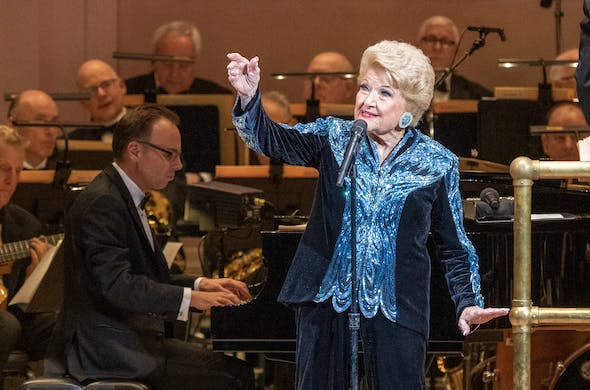Marilyn Maye at 95: Proving It When She Doesn’t Need To
The two-hour program was quintessential Maye, almost entirely material that’s been in her act for a while, now expanded to Pops proportions with orchestrations mostly by the formidable Tedd Firth.

Marilyn Maye With the New York Pops at Carnegie Hall
Steven Reineke, Music Director and Conductor
To no one’s surprise, this was a triumphant night for a veteran singer and entertainer at perhaps the single most iconic venue in all of American musical culture. I don’t doubt that some will make the comparison to Judy Garland in 1961, but the major difference is that Marilyn Maye, celebrating her 95th birthday at Carnegie Hall with the New York Pops Orchestra, had nothing to prove. Yet she proved it anyway, over and over and over.
The two-hour program was quintessential Marilyn Maye, almost entirely material that’s been in her act for a while, now expanded to Pops proportions with orchestrations mostly by her longtime musical director and pianist, the formidable Tedd Firth. (Along with bassist Tom Hubbard and drummer Mark McLean.)
I had some trepidation about whether the Pops’ customary concert format — two distinct acts with a 15-minute intermission in the middle — might dissipate some of Ms. Maye’s energy. Normally, she just charges ahead for as long as 90 minutes without a break, but I needn’t have worried: She returned for the second half at the same supercharged level of vitality.
I did note that most of the uptempo numbers, like her characteristic opener, “It’s Today,” complete with signature high kick, and most of her now-famous medleys arrived in the first half. Much of the slower material, the love songs like “Too Late Now” and the epic tragedies, such as “Guess Who I Saw Today” and “Fifty Percent,” appeared in the second act.
In addition to “It’s Today,” she took the stage with three familiar medleys, the first a sequence of seven songs by Cole Porter, the second a succession of four standards about rainbows, and later, two from “My Fair Lady.”
It was classic Marilyn, and her “solo concert” debut was obviously a big deal. Still, the main question was how much does the Pops Orchestra actually add to a performer and a trio that are already perfect without it?
The answer tends to vary from number to number. Steven Reineke and his Pops enhanced the medleys in that they felt more like compatible individual songs in a row — as in miniature concept albums — rather than squished together into a single number. Her special treatment of “Put On a Happy Face,” expands on the original arrangement from her 1965 breakthrough album, “Meet Marvelous Marilyn Maye.” It starts by using Alan Bergman and Lew Spence’s “That Face” as an extended intro, then lunges into the “Bye Bye Birdie” show tune, and later detours through a lengthy original patter section that makes “Happy Face” seem like a medley all by itself.
Some of her comic timing plays out differently on the big stage, as in the verse to “I Get a Kick Out of You,” when she says, “My story is much too sad to be told,” then pauses momentarily as if she’s not going to continue singing. She can still extract deadpan humor from stage announcements like, “I’m so glad that you’re here. But I have to say, I’m even more glad that I’m here.”
The big string orchestra enhanced the modulations, as on “Too Late Now,” and was especially welcome on the ballads. Mr. Firth provided a new Pops chart on “Joey, Joey, Joey,” and it was also quite amazing to hear classic arrangements by the late Peter Matz on that Lane-Lerner standard as well as on “You’re Gonna Hear from Me.”
The official closer in the program was “I’m Still Here,” the “Follies” anthem that we’ve heard Ms. May do a zillion times in the clubs. Somehow, the unfamiliar location and string background conspired to derail her concentration and it took a few minutes to get back on track — during which time she instructed the 80-plus union musicians behind her simply to “vamp — but by the time she reached the end, she was greeted with another of the evening’s numerous standing ovations.
She then wound up with two of her classic victory lap songs (I’ll take either one of them over “My Way”), James Taylor’s “Secret o’ Life” segueing into “Here’s to Life.” Before you knew it, we were on our feet and cheering once more. There were so many GASO’s (Stanley Dance’s acronym for “great american standing ovation”), it would take Stephen Hawking to count them all.
So, the good news is that it was a once-in-a-lifetime evening, a concert not to be missed. The better news is that even if you somehow weren’t there, Marilyn Maye will surely be back at Birdland and/or 54 Below within a matter of months, and she will be every bit as great as she was at Carnegie Hall.

